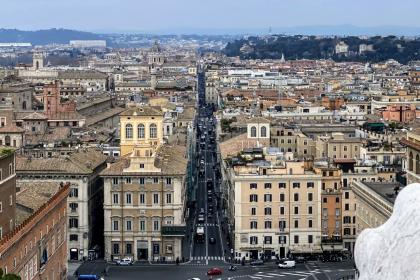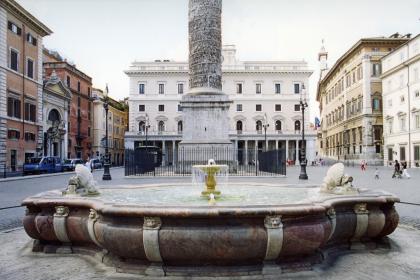
Situated between Via del Corso and Piazza Colonna, in a privileged position that places it in the heart of Rome's shopping streets and the sumptuous palaces of politics, Palazzo Ferrajoli stands on the ancient residences of the Del Bufalo-Cancellieri, a family of ancient Roman nobility with civil offices in the Curia and on the Capitoline Hill.
In the 16th century, the imposing building had partially frescoed façades but, in 1561, it was remodelled by the famous architect Giacomo Della Porta (1540-1602) and then renovated in 1626 by Francesco Peparelli - thanks to whose intervention it took on its current appearance - on the occasion of Paolo Del Bufalo's marriage to a Santacroce.
Home to high prelates, men-at-arms, and cardinals, it passed to the Marquises Niccolini following the marriage of one of Del Bufalo's daughters in 1728. During the Napoleonic Empire, Cardinal Joseph Fesch, uncle of Napoleon Bonaparte and French ambassador to Rome, settled there. In 1850, Marquis Giuseppe Ferrajoli purchased it.
The four-storey façade on Piazza Colonna is divided into three parts by four vertical ashlar bands, while between the second and third floors are string-course bands. On either side of the portal, you can see six large workshop doors alternating with four smaller ones. Square windows with simple frames open onto the mezzanine and attic; on the main floor are eleven architraved windows, the last of which opens onto a corner balcony on Via del Corso. The windows on the third floor have simple frames.
The façade on Via del Corso, also four storeys high, has shop doors on the ground floor; on the mezzanine are square windows with small balconies; at the left end of the piano nobile and both ends of the third floor, windows open onto balconies supported by corbels. The cornice supported by corbels has rosettes and heraldic elements of the Ferrajoli family; above it is a reredos with round arches. In the courtyard is a fountain with the Ferrajoli coat of arms.
Among the splendid halls of the palace, with period furnishings and precious decorations, we can mention the Sala dei Gigli, where Florentine lilies, the symbol of the Marchesi Niccolini, decorate the ceiling and tapestry; the Sala Colonna, from which you can enjoy a superb view of the Colonna Antonina and a magnificent optical illusion called the 'Crazy Column' whereby the further you move away from the window, the closer the column gets; the Sala Pio IX, which houses the Pope's gloves, slippers and other relics; the Sala Rossa, from which you can admire Palazzo Chigi, seat of the Italian government.
Finally, from the splendid terrace above the palace, you can enjoy a marvelous and evocative view over the rooftops of Rome's historic centre.
Via del Corso

 Condividi
Condividi
Chigi Palace

 Condividi
Condividi
Piazza Colonna

 Condividi
Condividi
Information
The building can be visited only during parties, congresses and exhibitions.
 Condividi
Condividi
Location
To find out about all accessibility services, visit the Rome accessible section.











































